Russian Railroads
Introduction
The players embody railroad moguls who have been commissioned to build the Trans-Siberian Railway, as well as
two additional railroads. In addition to track construction, the players will purchase new locomotives, promote
industrialization, and hire workers and engineers. All this is done in the lofty pursuit of acquiring the most victory
points – the truest measurement of a player’s rail building skills.
Clarification of rules as agreed with author and publisher
- Actions, players are competing for are to be performed completely, players are not allowed to omit those actions or parts of them.
If a player is not able to perform such an action completely, he may not choose that action. That applies to all actions on the game board (including the public
engineers) and the ?-cards.
- Actions, players are not competing for may be omitted. That will happen automatically, if the according actions cannot be performed anymore.
That applies to industry actions, hired engineers and ?-tokens.
- Actions a player gets during his move may be performed at any time.
Only choosing End Bonus cards will be postponed to the end of the move.
- If a player places a locomotive, he will have to complete this action including possible overbuilding of other locomotives before he can go on.
- If a player gets to use an action field once again due to the corresponding engineer or a factory, he has to choose that action field before he can go on.
Hints for handling
- You can get information on some things when clicking on them (the mouse pointer will change it's appearance):
text in history of move, engineers, locomotives and factories. Clicking on achievements that haven't met there conditions yet and therefore have no
green check mark will show wich requirements are still missing. If any of this information should not disappear after a mouse movement, you can close it with clicking
on that information.
- Numbers in parenthesis in the list of open actions in the history of moves indicate the number of mandatory actions.
- In most cases the implementation is able to decide whether an action field can be chosen or not and will
deactivate action fields not allowed. But sometimes it's not so easy to decide and may depend on the players actions. In those cases the
action field in question will be activated and the player can choose it. But if he is not able to execute ALL the actions of that field the
player will not be allowed to finish his move. In that case the player has to undo parts of or the complete move and choose another action field or perform the actions
in a way that he is able to perform all of them.
- No matter if a player uses coins or workers to 'pay' an action, workers will be placed on the according action field due to clarity.
Have a look at the history of moves to see how the action was actually paid. Since coins are kind of first-class workers an action will automatically be
paid with workers as long as possible. If there are not enough workers left the difference will be paid with coins.
- You can get an overview of all End Bonus cards when clicking on the according backside of that cards on the blue info panel.
If you haven't had a look on that cards, you will see all 10 cards available despite the fact that 2 of them were randomly sorted out in the beginning.
Otherwise the overview will reflect the information you got by having a look at the cards.
- A click on the eye on the top left of each player's board will show you the according board in a bigger view. A click on the star with the
question mark in a blue circle will show you an overview of the actual score of that board.
Moreover there is listed how many engineers each player has hired, their highest number and their sum. The points players would get when the
majority of engineers would be scored right now are listed in that overview, too.
Game Components
| 1 | game board |
| 35 | workers (8 in each of 4 player colors, 2 turquoise, 1 black) |
| 8 | pawns (2 in each of 4 player colors) |
| 48 | tracks (12 black, 12 gray, 12 brown, 8 natural, 4 white) |
| 8 | Industry markers |
| 4 | player boards |
| 37 | locomotives (4 of each of the #1-8 locomotives, 5 of the #9 locomotives) |
| 15 | engineers |
| 20 | Doubler tokens |
| 18 | roubles (coins) |
| 28 |  -tokens (4x 7 different tokens) -tokens (4x 7 different tokens) |
| 4 | Revaluation markers |
| 4 | Kiev Medals |
| 1 | Last Round marker |
| 4 | 100/200-point tokens |
| 4 | 300/400-point tokens |
| 10 | End Bonus cards |
| 5 |  -cards -cards |
| 4 | Turn Order cards |
| 4 | Starting Bonus cards |
| 1 | detailed rulebook |
| 4 | Scoring Overview cards |
In the following the setup for 4 players is shown. The changes required for
2 players or
3 players are described later on.
Setup
Board setup for 4 players

- Place the game board in the middle of the table.
- Place the 100/200 and 300/400-point tokens near the space 100 of the scoring track.
- Lay the 5
 -cards face up.
-cards face up.
- Shuffle the 10 End Bonus cards and remove two of them from the game without looking at them. The 8 remaining cards form a face down pile.
- Place the 37 locomotives next to the board so that they are locomotive side up (the purple side will come up later).
Sort them by number and place them so that they form 9 distinct piles as seen below.
One of the #9 locomotives has no purple backside and should be placed on its matching
 -card.
-card.
- Place the 2 turquoise workers on the area of the board displaying 2 turquoise workers.
Place the black worker on its matching  -card.
-card.
Give each player 7 of the workers in their player color (1 worker of each color is returned to the box).
- Form a supply with the 18 roubles (coins).
- Form a Doubler token supply using the 20 Doubler tokens (called 'doubler' for the remainder of this rulebook).
- Form a track supply by sorting the 48 tracks so that they are grouped by color.
- First sort the 15 engineers into a A and B pile. (One engineer is not marked with a letter and should be placed on its matching
 -card along with a single rouble.
-card along with a single rouble.
Shuffle the A and B piles separately. Place the top 4 engineers of the B stack on the spaces marked 6, 5, 4 and 3. Place the top 3 engineers
of the A stack on the spaces marked 2, 1 and the rouble.
Engineers placed horizontally should be light side up. Engineers placed vertically should be dark side up. (The engineers and the spaces they occupy
have a distinctive form to help remind players which side should face up.)
Remove the remaining engineers from the game.
- The Last Round marker is placed near the game board. It will be required for the last round of the game.
Setup player for 4 players
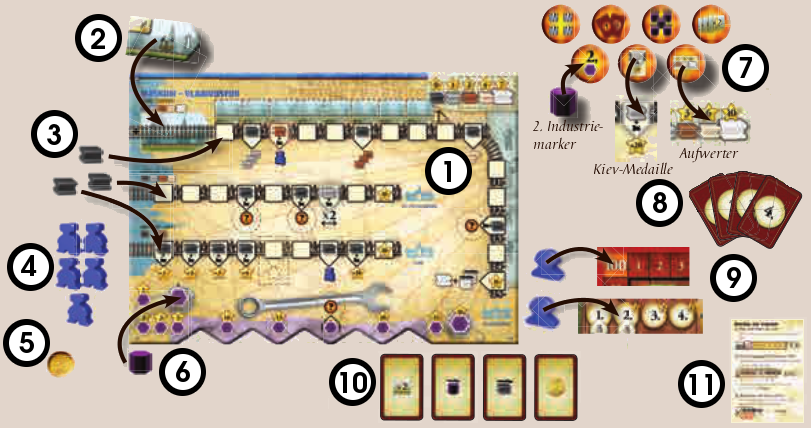
- Each player selects a color and places the matching player board in front of herself.
- Each player receives a #1 locomotive from the supply and places it on the appropriate space at the upper left of her player board.
- Each player receives 3 black tracks from the supply and places them on the first space of each of the three railroads pictured on her player board.
- Each player receives 5 workers in her color and places them before her. The remaining 2 workers are placed near the game board in a supply.
- Each player receives 1 rouble from the supply.
- Each player receives 1 industry marker and places it on space 0 of the industry track.
- Each player receives 7 different
 tokens, a second industry marker, 1 Kiev Medal and 1 Revaluation token. She places everything near her player board.
tokens, a second industry marker, 1 Kiev Medal and 1 Revaluation token. She places everything near her player board.
- Shuffle the 4 Turn Order Cards and place one number-side-up in front of each player.
- Each player receives 2 pawns in her color: one to place on the 100 space of the scoring track; another to place on the space of the turn order track matching her Turn Order card.
- Lay out the 4 Starting Bonus cards. The player 4th in turn order takes one, uses its ability and removes it from the game. The player
3rd in turn order does the same, followed by the player 2nd in turn order. The player 1st in turn order receives no Starting Bonus card.
The remaining Starting Bonus card is returned to the box.
- Each player receives a Scoring Overview card.
Game Play
The players take actions one after the other in order, until all players have passed. At the end of each round, players
score points as a measurement of their progress.
In the four-player game, the game ends after the seventh round.
Playing a turn
 Each turn a player will choose an unoccupied action space, occupy it with the required number of workers
and perform that action.
Each turn a player will choose an unoccupied action space, occupy it with the required number of workers
and perform that action.
You must consider the following:
- You must choose an unoccupied action space (i.e. one that is not already occupied by workers).
- You must place the correct number of workers required for the action space you wish to use.
- You must only use workers from your personal worker supply.
- You must immediately make use of the chosen action
- You must perform the action in its entirety.
- You may perform only one action per turn.
Note: exceptions to these rules will be noted where applicable..
Note: We use the word “must” to ensure players clearly understand how the game is to be played. There are
only positive actions. In most cases, a player will only take an action they want to perform.
The areas of the board - possible actions
- Track extension
- Locomotives and factories
- Industrialization
- Auxiliary actions
- Engineers
- Turn order track
Track extension
The track extension actions are among the most important in the game
Each player’s personal player board depicts 3 railroads, which can be independently extended over the course of the game.
These railroads will be called Trans-Siberian railroad, Petersburg railroad and Kiev railroad for the remainder of this rulebook.
The better each of their railroads is developed, the more points each player will score at the end of each round.
First, place the required number of workers on one of the track extension action spaces. Then, advance the
appropriate track(s) on your player board the number of spaces indicated on the action space.
You may choose to distribute track advancements between multiple railroads.
And so ends the action.
In order to earn more points, the players should strive to extend their railroads
through the advancement of these tracks. To maximize their progress, players will
also need to advance tracks of other colors, indicating tracks of higher value.
In order to advance the tracks in the other colors, you must first earn them. Your earn these tracks by advancing
the black track to spaces 2, 6, 10 and 15 on the Trans-siberian.
Once a player has advanced the black track to or beyond space 2 of the Trans-siberian, she immediately takes 3 gray tracks from the general
supply. She places these new tracks to the left of each railroad depicted on
her player board. She may now begin advancing her gray tracks.
When a player’s black track reaches or passes space 6 of the Trans-siberian, the player
receives 3 brown tracks, space 10 grants access to 2 natural tracks and space 15 to 1 white track.
The following must be observed when advancing tracks:
- Tracks advance in a specific unchangeable order:
first black, then gray, brown, natural and finally white.
- A track can only be moved onto an empty space. A track
may never catch up to or go beyond the track that is in
front of it. As such, the order is always respected.
- Advancements may be split between different railroads.
- Not all railroads use every track color. Your player board
shows which colors go with which railroads.
The two actions at the bottom of the area of rail extension
 To use this action, you must place a worker and 1 rouble. This action gives you two advancements of
your choice (split between 1 or 2 tracks).
To use this action, you must place a worker and 1 rouble. This action gives you two advancements of
your choice (split between 1 or 2 tracks).

This is the only action in the game that may be used more than once during a round. When a player places a worker there, she must then
move either a black or a gray track. The action space is not considered occupied and may be used again during the same round by any player (including players
who have already used it).
Locomotives and factories
Building locomotives
First, place the required number of workers on one of the locomotive action spaces. Then, take 1
locomotive from the
lowest numbered pile in the supply. Finally, place this locomotive in front of one of the 3 railroads of your
player board.
There can be only 1 locomotive on these railroads: st.petersburg and Kiev. There can be up to 2 locomotives
on the Trans-Siberian. The number of a locomotive indicates the number of spaces it can reach on a railroad.
The
Trans-Siberian is the only railroad where there can be 2 locomotives. One of these is placed next to the board
to the left of the track, while the other is placed directly on the board. You must add up the value of both locomotives
on the Trans-Siberian to determine the total number of spaces that can be reached on this railroad.
Upgrading locomotives
To upgrade a locomotive, simply replace it with one whose number is
higher.
The “old” locomotive is not lost: you can move it to one of the other two railroads.
When you move an “old” locomotive to a railroad where there is a locomotive, this can create a chain reaction.
When a player is unable to place a locomotive, she flips it purple side up and places it next to the locomotive
supply. That locomotive will now be used as a factory. What are factories? They will be
explained in the next section.
During each end of round scoring, you will only score points for the spaces that your locomotives can reach.
Furthermore, special spaces are spread amongst your railroads, and in order to benefit from
their advantage, you must first reach them with a locomotive.
Factories
Factories are essential to the industrial development of your railroad network. Not only that, but each factory can
be used to benefit from a unique ability.
A factory is depicted on the back of each locomotive. Locomotives with the same number all have the same factory
on their back. Each factory grants its owner a special ability that she can benefit from. The ability a factory
possesses is also depicted in the top left corner of a locomotive.
Building Factories
To build a factory, you must use the same actions that were required to build locomotives.
First, place the required number of workers on the action space. Then, just like you did for the locomotives, take a
locomotive from the
lowest numbered pile in the supply.
Flip this locomotive purple side up (with the factory) and place it under your board, in one of the 5 spaces reserved
for factories. You must place your factories
from left to right. If a player wishes to build a factory and there
are some factories next to the locomotive piles, the player will be able to choose between one of the face up factories
or one from the lowest numbered pile.
If you manage to fill your 5 factory spaces, you can replace them with other factories. When you wish to replace
a factory, you must first place one of your “old” factories in the general supply, to the left of the locomotive piles,
factory side up (purple side). Then, you place the new factory in the recently freed space. You do not have to
replace your factories from left to right.
Note: How factories are used will be covered in the next section “Industrialization”.
Industrialization
Another type of action is possible: industrialization. Industrialization lets you score points during the scoring phase
at the end of a round, and also gives you access to the abilities of your factories.
First, place the required number of workers on one of the industrialization action spaces. Then, advance your
Industry marker the number of spaces indicated by the chosen action space. You will notice that there is a gap after the first 4 spaces of your
industry track. You cannot move your Industry marker into or beyond this gap.
For your Industry marker to progress on your industry track, you must first fill these gaps with factories. This
represents another way in which your industries are improving.
Each factory features an industry space

onto which your Industry marker can move.
After each factory there is another industry space

that becomes available.
When a marker moves onto a factory, you must then
immediately use that factory’s ability. If you are unable to
use it at that time, the effect is cancelled.
The various abilities are explained
here.
Auxiliary actions
- 1 Doubler
Place 1 worker on this action space to take 1 doubler from the supply. Then, you must place
this doubler on an empty dashed space above the Trans-Siberian (and only there). You
must fill these 8 spaces from left to right and there may only be 1 doubler per space. A track does not have to be present for you to be
able to place a doubler. A doubler multiplies by 2 (doubles) the value of the space below it during scoring.
- 2 Roubles
Place 1 worker on this action space to take 2 roubles from the supply and then place them in front of you.
Roubles may replace workers when playing on action spaces.
Although roubles can replace workers, workers cannot replace roubles. Like action spaces occupied by one or more
workers, an action space that is occupied by a rouble cannot be used again during this round.
- 2 temporary workers
Place 1 worker on this action space to take the 2 turquoise temporary workers. You must
use these workers during this round, and they act as if they were your own color.
Just like roubles, you can use temporary workers by themselves (individually or together), or combine them with
workers of your own color or roubles.
You may not keep the temporary workers for the next round.
Engineers
Hiring engineers
Engineers can help players during the game with their special skills. They can also give players a certain number of
points at the end of the game.
Each round, only one engineer can be hired. The engineer that can be hired is located in the right-most space
(the hiring space) of the engineer area of the game board. To hire an engineer, you must place a rouble on the hiring action space. You then take the engineer from this
space and place it, light side up, close to your player board.
The light side of each engineer shows an action. If a player has one or more engineers next to his game board, he
may use these actions just like those from the game board. A player may use his engineer actions,
even if he is unable to use the action completely.
Another advantage to having “your own engineers” is that they are not “time sensitive”, meaning that since the
other players do not have access to them, you are able to use them exactly when you need to.
The 2 light side up engineers on the game board
Both engineers that are placed light side up on the board allow players to use their respective action. Players are
unable to hire these engineers. They represent extra action spaces available to all players, just like all other action
spaces on the game board (track extension, locomotive, etc.). And just like all other action spaces on the board,
these actions can only be used once per round.
The 4 left-most engineers
These engineers can neither be used nor hired. However, at the end of a round, every engineer is moved one space to the right.
In other words, these engineers will become available during future rounds. Seeing them lets players plan ahead for the rounds to come.
Turn order
In this game, players do not play in clockwise order. The turn order track is used to determine player order. The
player occupying the first position plays first, followed by the player occupying the second position, and so forth.
Once the last player has taken her turn, it is once again the first player’s turn to play.
When a player does not wish to or cannot continue playing, she passes; this means that for the remainder of this
round, she will not be able to play. Finally, to show that she is out of this round, she flips her Turn Order card and
immediately scores the points shown on the back of her card.
The other players keep playing, one after the other, until every player has passed.
Note:Even if a player runs out of workers, this does not mean that she must pass right away. She can continue
performing actions with roubles.
You can place one of your workers under the
first or
second position of the turn order track.
This will be your position in the turn order sequence of the following round.
You
may not place a worker on the action space under your current position
in the turn order, nor may you occupy both turn order action spaces.
Once every player has passed, the players who placed a worker under the turn order track remove their pawn. To
free the turn order spaces, the other pawns are moved to the right (towards the last spaces of the turn order track).
Then, the players place their pawn on the turn order space above their worker.
Special case: If the first player places a worker on the 2nd position (probably because she does not wish to move further back) and that no other
player places a worker on the 1st position, the turn order will not change.
Note: As you may have noticed, it is very important to know which player
places a worker on the turn order action spaces. To this effect, if a player places a worker that is not of her color or a rouble, she must immediately
exchange it with a worker of her color placed on another action space
A worker on a turn order action space provides another benefit. Once the turn order has been reorganized, players
who placed a worker on the turn order action spaces can each move their worker to a free action space.
The player whose worker occupies the 2nd position is first to move her worker. She takes her worker from the turn
order action space and moves it to a free action space of her choice (this can be one of her engineers). She then
performs the corresponding action.
Then, the player who placed his worker on the 1st space does the same, following the same rules.
When moving your worker, you must observe the following:
- You may only move your worker to an action that
requires exactly 1 worker (i.e. you may not combine it with other workers, temporary workers, or roubles).
- If there are no better options, you can always use the bottom track extension action
- In the previously described special case a player moves her worker, too.
Player board

- The 3 railroads Trans-Siberian, Petersburg und Kiev
- room for locomotives
- room for factories
- Industrialization
- room for the engineers
- 8 spaces for doublers
The spaces circled in red give you various advantages.
To get these advantages (shown below the space or next to it), you must first fulfill certain conditions.
Before acquiring the advantage that a space gives, you must always at least reach the space
with a track. Sometimes, a locomotive
must also reach that space. The following pages present these special
spaces in two groups: those that do not require a locomotive and those that do.
Without a locomotive
- On spaces, 2, 6 and 10 of the Trans-Siberian, you get the tracks depicted below each space, as
explained in section building tracks.
Space 15 allows you to get the white track. On top of that, you can immediately advance
it up to 2 spaces. You must follow the usual rules (only on empty spaces, no passing), otherwise you
lose the advancement(s) you cannot use.
- When you reach the last space of a railroad with the
black track,you immediately score 10points. A railroad may not be extended beyond the last illustrated space.
- If you reach space 7 of the Kiev railroad with your black track, you immediately receive one
worker of your color from the general supply. You may use this worker immediately and for the rest of the game.
With a locomotive
- If you reach space 3 of the trans-siberian with your brown track and a locomotive, you
immediately receive one worker of your color from the general supply. You may use this worker immediately and for the rest of the game
- If you reach space 7 of the St.Petersburg railroad with your gray track and a locomotive, the value of every scored space of this railroad is doubled during the scoring phase.
- If you reach spaces 1 through 4 or space 8 of the Kiev railroad with your black track and a locomotive, you score the points
depicted in the stars during future scoring phases. These points are cumulative. For example, if your track is on space 3 and you have a #3 locomotive (at least),
in each future scoring you will score 6 bonus points (1+2+3 points).
- If you reach space 13 of the Trans-siberian, or spaces 4 or 6 of the St.Petersburg railroad with your
black track and a locomotive, you choose one of your 7
 tokens, apply its effect and then place that token in the dashed space with a
tokens, apply its effect and then place that token in the dashed space with a  .
This space may not be used again to receive another token.
.
This space may not be used again to receive another token.
Industry track
To receive this advantage, your Industry marker must reach this space on the industry track.
(There is no track or locomotive requirement for this space.) You then proceed as described
above for the

spaces.
This space
may not be used again to receive another

token.
Scoring phase
At the end of each round, once every player has passed and the turn order has been reorganized, the scoring phase happens.
These two elements on each player’s individual boards are scored:
- their 3 railroads
- their industrialization progress
Scoring the 3 railroads
- In principle, only spaces reached by a locomotive are scored.
- Each track on a railroad can score points. The value of each track is determined by its color, as shown in the upper right corner of the board.
- A track scores points for the space it occupies and all empty spaces behind it. These empty spaces count as being occupied by tracks of the same color (=virtual tracks).
Scoring the industrialization
In addition to your tracks, you also score the points noted on the space on the industry track currently occupied
by your Industry marker. Spaces that do not show any points (for example, the factories) are worth the same
amount of points as the first previous space worth points.
Preparing the next round
Once all players are done with their scoring, they must prepare the next round.
To be ready for the next round:
- All players must return their workers to their personal supply.
- All placed roubles are returned back in the general supply.
- Both turquoise workers are returned to the corresponding action space.
- One player moves the engineers.
All engineers are moved 1 space to the right. If there is still an engineer on the hiring space, that engineer is
returned to the box. Engineers must always be light side up on the changing action spaces, otherwise they
should be dark side up. You will need to flip some engineers when you move them from one section to
the next.
Note: Each space under an engineer shows a number. This is the number of rounds left to play.
- Finally, each player takes the Turn Order card corresponding to her new position in the
turn order. That card is placed number-side-up in front of them.
You are now ready for the next round!
Warning! This applies only for the last round:At the beginning of the last round (round 7 with 4 players), the Last
Round marker is placed over the turn order action spaces. During the last round, these actions are useless; this is why they are replaced
with a new action: 3 advancements on the industry track.
Game End
After the scoring phase at the end of round 7, a final scoring takes place, and then the game is over.
The final scoring consists of 2 parts:
- End Bonus cards
Players reveal their End Bonus cards at this time.
Note: Usually, each player will end the game with one End Bonus card. However, it is possible, with the help of factories, to acquire more End Bonus cards. It is even possible for
a player to end the game without any End Bonus cards, but we strongly advise against this.
End Bonus cards are presented here.
- Majority of Engineers
The player with the most engineers scores 40 points. The player with the second most engineers scores 20 points. In case of a tie,
the tied players look at the numbers on their engineers; the player with the engineer that shows the highest number
wins the tie.
Note: A player that does not have any engineers may not score these bonus points.
The game is over after the final scoring. The player with the most points is the winner.
In case of a tie, the tied players share the victory.
Playing with 2 players
Setup
- The board is two-sided, with one side reserved for
2-player games. The “blocked” actions are unavailable.
- Return 2 locomotives of each number to the box.
- There are only 6 engineers (3x A, 3x B) (as seen by the number of engineer spaces on the board)
- Players take the 8 workers in their color. The remaining 16 workers (the other player colors) are returned to
the box and will not be used. Each player begins the game with 6 workers instead of 5
- Each player begins the game with 2 roubles instead of 1
Gameplay
- The game lasts 6 rounds.
- A player may place a worker on his current turn order action space.
Playing with 3 players
Setup
- Return 1 locomotive of each number to the box.
- There are only 6 engineers (3x A, 3x B). The left-most engineer space remains empty.
- Players take the 8 workers in their color. The remaining 16 workers (the other player colors) are returned to
the box and will not be used. Each player begins the game with 6 workers instead of 5.
Gameplay
Tactical hints
- Pay attention to the track extension actions. It is important not to forget to
extend your more valuable tracks when possible.
- Pay attention to the locomotives you build, and make sure that they reach the
special spaces (for example, a #2 locomotive on the St.Petersburg is not very useful).
- The changing action spaces (engineers) are very useful.
- Roubles are more flexible than temporary workers.
- You should aim to acquire at least 2
 tokens.
tokens.
- Industrialization is worth a lot of points at the beginning. But fear not, extending your tracks will pay greatly by the end of the game
4 Starting Bonus cards

Get 1 black track advancement.

Get 1 industry advancement.

Place 1 doubler above the Trans-Siberian.

Take 1 extra rouble.
7  tokens
tokens

Place your second Industry marker on space 0 of the Industry track. From now on, whenever you get an industry advancement,
you may choose which marker to move. If you get an industry advancement of more than one space, you may split it amongst your two
markers. Both markers may never occupy the same space. During the scoring phases, both markers are scored.
When your 2nd marker moves onto a factory, you benefit from it a second time. You may not use the

space a second time.

Get 5 industry advancements.

Choose one of the

cards and apply its effect immediately. Afterward, return the card
to the box, it will not be used again during this game. Then, you may look through the End Bonus card pile and take the card of your choice. Keep it face
down in front of you; it will allow you to score many points at the end of the game.

Get 4 advancements to use with the tracks of your choice. You must use them with tracks you currently have. If you acquire new
tracks while using this token, you may move these tracks immediately (even with this token).

Place 3 doublers above the Trans-Siberian.

Place the Kiev Medal under space 5 of the Kiev railway. In each following scoring, if you reached space 5 with the gray track and a
locomotive, you score an additional 20 points.

Place your Revaluation token at the topright corner of your player board. From now on, your brown, natural and white tracks are
worth more points.
5  cards
cards
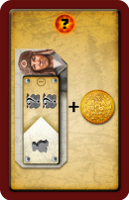
Take the engineer and the rouble from this card.
Place the engineer near your player board, where appropriate, and place the rouble in front of your personal supply. Both are
available immediately.
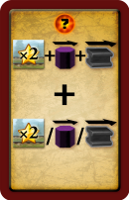
Perform 4 actions:
* place 1 doubler,
* get 1 industry advancement, and
* get 1 black rail advancement.
Perform 1 of these 3 actions a second
time.
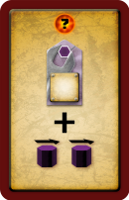
Build a factory. You also get 2 industry advancements to use immediately.
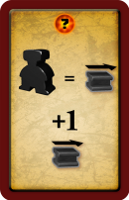
Take the black worker. This gives you an extra worker for the rest of the game.
Furthermore, each time you use the black worker on an action space that grants at least 1 black rail advancement, you get an
extra black rail advancement.
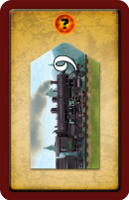
Take the #9 locomotive from this card and immediately place it on one of
your railroads. As usual, you can replace a locomotive with this one, and any
advantage acquired by placing this locomotive is applied immediately.
10 End Bonus cards
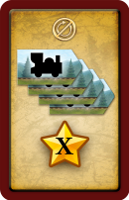
During the final scoring, add the
numbers on your locomotives and score that many points.
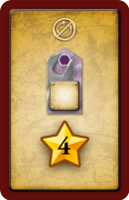
During the final scoring, score 4 points per factory in your industry track (max. 20 points).
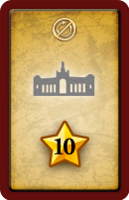
During the final scoring, score 10 points per completed railroad (max. 30 points).
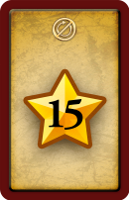
During the final scoring, score 15 points.
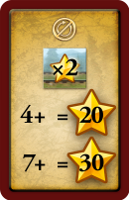
During the final scoring, score 20 points if you have 4, 5, or 6 doublers above the Trans-Siberian.
If you have 7 or 8 doublers, score 30 points.
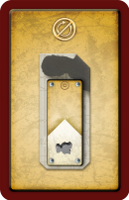
During the final scoring, this card counts as an additional engineer when determining the player with the most engineers.
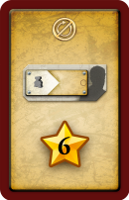
During the final scoring, score 6 points per hired engineer. (The engineer from the End Bonus card, seen above, does not count for this.)
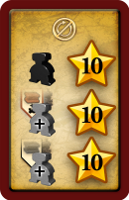
During the final scoring, score 10 points per extra worker you acquired during the game. This includes
both extra workers of your color and the black worker (max. 30 points).

During the final scoring, score 7 points per

token on your
board (max. 28 points).
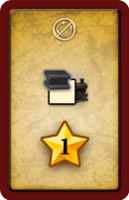
During the final scoring, score the sum of the 3 spaces reached by your black tracks.
Whenever you have the option of taking an End Bonus card, you can look through the pile. Then you either can choose the card
that you want
or immediately score 10 points.
Engineers

You get 2 track advancements of your choice.

You get 1 industry advancement and immediately score 3 points.

You get 1 black track advancement and 1 gray track advancement.

You place 1 doubler above your Trans-Siberian and immediately score 3 points.

You get 1 track advancement of your choice and immediately score 3 points.

You get 1 gray track advancement and immediately score 5 points.

You get 1 black track advancement and immediately score 3 points.

You choose an action space with one (and only one) worker of your color and use that action again.

You get 2 industry advancements.

You get 1 industry advancement and 1 black track advancement.

You get 1 track advancement of your choice and 1 black track advancement.

You get to build 1 locomotive or 1 factory.

You get 1 gray track advancement and 1 brown track advancement.

You get 2 black track advancements.

You get 1 brown track advancement and immediately score 5 points.
Factories

Immediately score the sum of your engineers (the sum of their numbers).

Build a locomotive or a factory.

Choose an action space with one (and only one) worker of your color and use that action again.

Place 2 doublers above your Trans-Siberian.

Get 1 industry advancement.

Take 1 rouble from the supply and place it in front of you.

Get 2 track advancements of your choice.

Score the sum of your best two locomotives.

Choose one End Bonus card or immediately score 10 points.